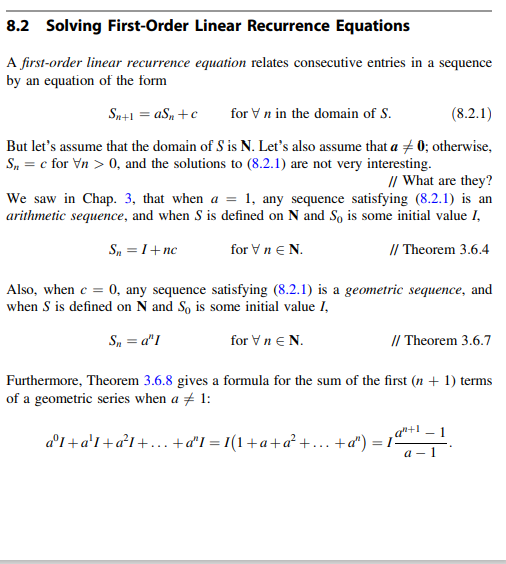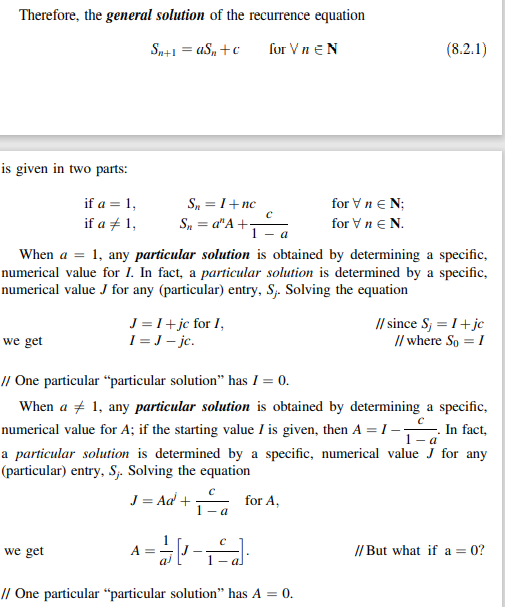Solve the first-order linear recurrence relation: Sn+1 = 5 Sn + 1, with S0=1.
Algebra & Trigonometry with Analytic Geometry
13th Edition
ISBN:9781133382119
Author:Swokowski
Publisher:Swokowski
Chapter5: Inverse, Exponential, And Logarithmic Functions
Section5.6: Exponential And Logarithmic Equations
Problem 64E
Related questions
Question
Solve the first-order linear recurrence relation: Sn+1 = 5 Sn + 1, with S0=1. You may use the general solution given on P.342.

Transcribed Image Text:8.2 Solving First-Order Linear Recurrence Equations
A first-order linear recurrence equation relates consecutive entries in a sequence
by an equation of the form
Sn+1 = aS, +c
for Vn in the domain of S.
(8.2.1)
But let's assume that the domain of S is N. Let's also assume that a + 0; otherwise,
S, = c for Vn > 0, and the solutions to (8.2.1) are not very interesting.
I/ What are they?
We saw in Chap. 3, that when a = 1, any sequence satisfying (8.2.1) is an
arithmetic sequence, and when S is defined on N and So is some initial value I,
S, = 1+nc
for Vn e N.
// Theorem 3.6.4
Also, when e = 0, any sequence satisfying (8.2.1) is a geometric sequence, and
when S is defined on N and So is some initial value I,
S, = d"I
for Vn e N.
I/ Theorem 3.6.7
Furthermore, Theorem 3.6.8 gives a formula for the sum of the first (n + 1) terms
of a geometric series when a + 1:
a°1+a'I+a²I+.. +a'I = 1(1+a+a² +... +a") = 1ª
а - 1

Transcribed Image Text:Therefore, the general solution of the recurrence equation
Sp+1 = aS, +c
for Vn eN
(8.2.1)
is given in two parts:
if a = 1,
S, = 1+nc
for Vn e N;
if a + 1,
S„ = a"A +•
for Vn e N.
When a = 1, any particular solution is obtained by determining a specific,
numerical value for I. In fact, a particular solution is determined by a specific,
numerical value J for any (particular) entry, S,. Solving the equation
J = I+jc for I,
1 = J – je.
I/ since S; = I+jc
// where So =1
we get
// One particular “particular solution" has I = 0.
When a + 1, any particular solution is obtained by determining a specific,
numerical value for A; if the starting value I is given, then A = 1-,
In fact,
1- a
a particular solution is determined by a specific, numerical value J for any
(particular) entry, S,. Solving the equation
J = Ad +
for A,
a
we get
A =
// But what if a = 0?
// One particular “particular solution" has A = 0.
Expert Solution
This question has been solved!
Explore an expertly crafted, step-by-step solution for a thorough understanding of key concepts.
This is a popular solution!
Trending now
This is a popular solution!
Step by step
Solved in 2 steps with 2 images

Recommended textbooks for you

Algebra & Trigonometry with Analytic Geometry
Algebra
ISBN:
9781133382119
Author:
Swokowski
Publisher:
Cengage

Linear Algebra: A Modern Introduction
Algebra
ISBN:
9781285463247
Author:
David Poole
Publisher:
Cengage Learning

Algebra & Trigonometry with Analytic Geometry
Algebra
ISBN:
9781133382119
Author:
Swokowski
Publisher:
Cengage

Linear Algebra: A Modern Introduction
Algebra
ISBN:
9781285463247
Author:
David Poole
Publisher:
Cengage Learning